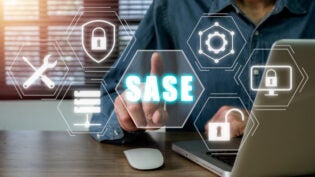A Brief Overview of Endpoint Encryption for Small Businesses
By: Ryan Kidman

Cyber threats and concerns are ubiquitous these days. It isn’t uncommon to hear about an aggressive breach or hack affecting a big corporation or large-scale service provider. Small businesses aren’t insulated from such problems. They’re especially vulnerable to such issues, and using some type of defensive measure is imperative to prevent problems.
That’s where endpoint encryption comes into play. Small businesses need to build trust with their customer base and protect their data at the same time. To that end, safeguarding sensitive data and preventing breaches is paramount to running your operation.
Here’s a brief overview of endpoint encryption and how it can help a small business succeed:
Endpoint encryption explained
Endpoint encryption is a standalone security solution that can protect various devices – including USB and removable media – from possible intrusions or breaches when used in conjunction with other security methods. The goal is to protect confidential data and intellectual property without letting it fall into the hands of hackers. Endpoint encryption is not an antivirus, firewall, or standard network security. It handles encryption at an access point to the network – which could be anything from a laptop to a mobile phone. When used in conjunction with other network security methods, endpoint encryption helps protect your organization’s privacy, data, intellectual property, and more.
Implementing encryption at your business
Successfully implementing and incorporating endpoint encryption is easy and straightforward. Once you’ve selected the best endpoint encryption software for your organization’s needs, it’s merely a matter of deploying it. The process begins with ensuring your system meets the software’s requirements; otherwise, it will be ineffective. Once you finish deploying the encryption software, be sure to make use of the different types of encryption available.
Whether it’s whole drive encryption for protecting entire disks or FFRM encryption for protecting individual files, folders, or removable media, you’ll need flexibility for both hardware and software encryption. Once installed, the software helps you manage endpoint encryption across the entire organization through advanced reporting and tracking methods, in addition to real-time auditing.
Enhance privacy and compliance
As a small business, you need to protect both proprietary and customer data. Advanced threats and breaches can strike at any time, exploiting vulnerabilities in your network and generally making things difficult for your operation. The most significant benefit of using endpoint encryption lies in its ability to protect your organization’s privacy and data while meeting regulatory compliance standards.
Pre-boot authentication is sort of the secret weapon in protecting privacy and data. what’s not to love about it? It supports multiple user and admin accounts for each device, allows you to configure what happens if somebody tries to enter the wrong password too many times, and it updates policies prior to authentication.
Policies, when it comes to endpoint encryption, are the set of behaviors the central management portion of the software gives to the protected/encrypted devices. When you consider the multi-factor authentication available and the dynamic, active nature of the protection these types of programs offer, it’s imperative to implement one as soon as possible.
Comprehensive data security
Data breaches can occur in numerous ways. A critical drive or removable disk may get stolen or become compromised. Existing or unpatched security vulnerabilities could cause more significant problems. Perhaps employees used insecure or weak passwords for their accounts, making it easier to hack into the network or individual devices.
Regardless, an all-in-one encryption solution supplements privacy protection and data security with a centralized management system. Endpoint encryption at the business level is completely different from what a consumer uses, and it functions on a totally different level. The centralized management system uses specific and precise policies for moving data in and out of endpoints. This creates encryption that can only be accessed via “keys.” These keys are registered, backed up, and the file/drive is protected.
Attempts to access data secured in this manner are met with blocks, lockouts, time-based protections. Integrating a powerful software that can handle proper encryption techniques on a large scale is the best way to maintain comprehensive data security at all levels of an organization.
System recovery and fail-safes
Imagine this scenario: one of your devices—a hard drive, disk, or some form of removable media—mysteriously goes missing from your organization. The contents of the device contain valuable data and intellectual property. You have no insight as to the whereabouts of the drive and grow increasingly concerned/alarmed about the security of your company’s data.
If a similar scenario plays out in real-life, encryption software is your first line of defense to secure the data and prevent devices from being accessed. All is not lost! Through remote device management and the power to activate a remote “killswitch” for any protected devices, you can rest easy knowing you can immediately disengage a vulnerable or missing device by resetting or killing a device before it has a chance to go into pre-boot authentication. You can also keep track of various device attributes and location through remote device management.
With these features at your fingertips, you’ll be securing your data—and your organization’s future—in no time.
1904 Views













